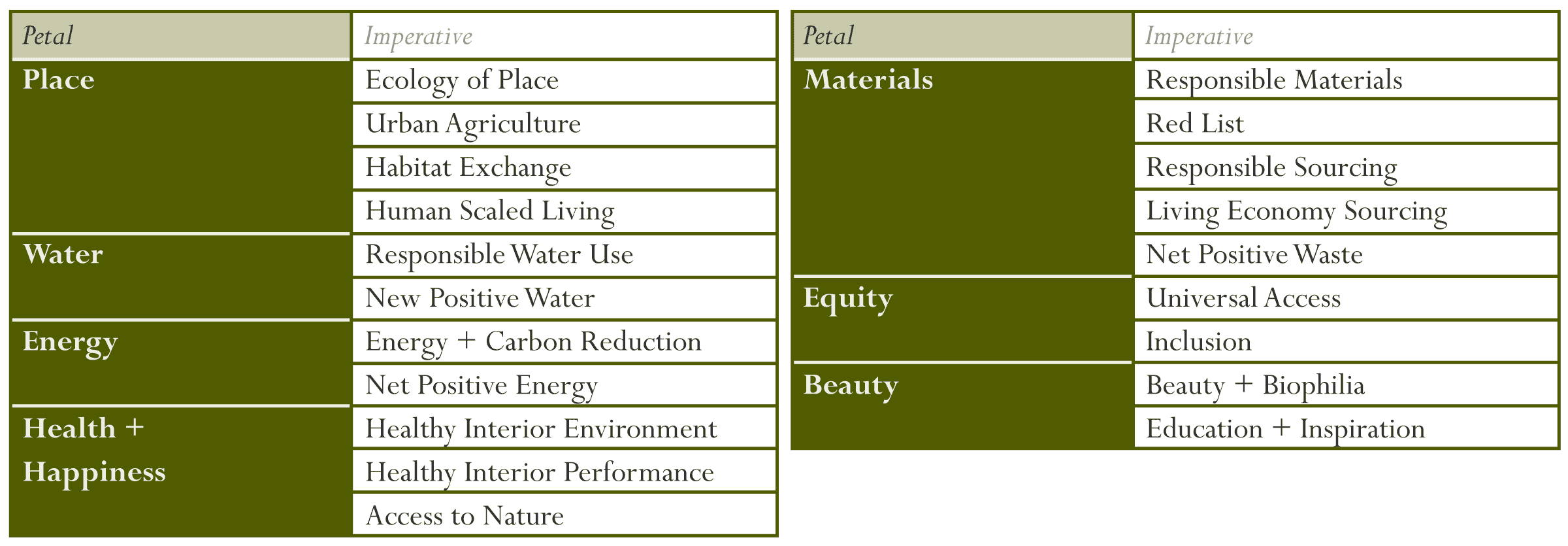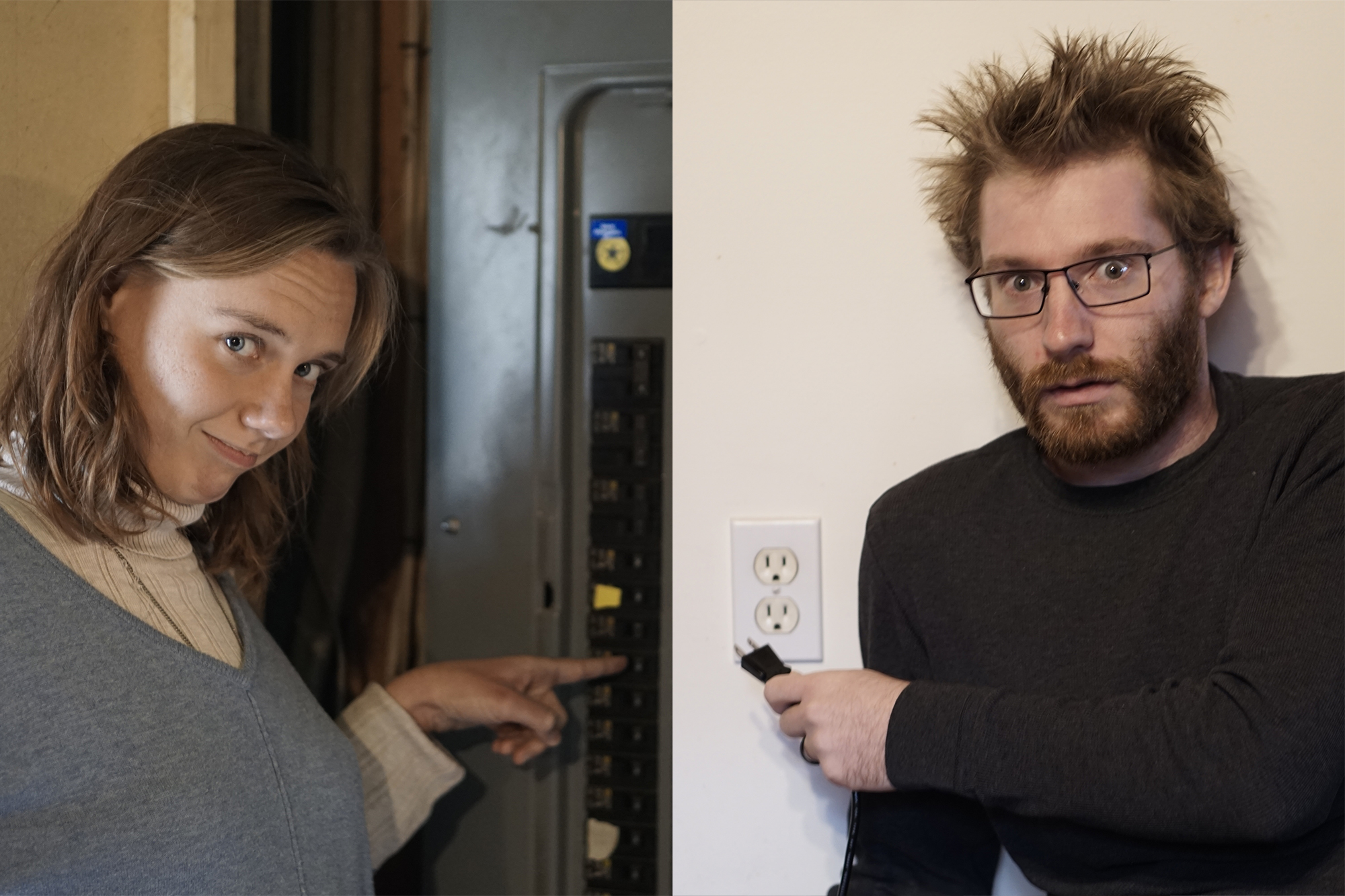LBC: The Energy Petal
Dear Readers,
First came place, then came water. Now, comes energy…dun, dun, dun! The Energy Petal is the third of the seven petals for the Living Building Challenge.
Ha! I was going to say that we have high hopes for this one…but we have high hopes for the Water Petal and the Petal of Place, too. There are just way too many high hopes floating around this joint! But. If you are willing to stick with us (whether you are amused or annoyed by our ideas…), then William and I would be most honored to share our highness of hope with you!
To refresh your memory, here is a chart with all seven petals and their imperatives.

The Seven Petals of the Living Building Challenge and their Imperatives
In this blog, we are going to be focusing on Energy!

The Energy Petal and its Two Imperatives
The Energy Petal
The Energy Petal has two Imperatives: Energy and Carbon Reduction, and Net Positive Carbon.
To achieve the Energy and Carbon Reduction Imperative, a new building must reduce its energy consumption by 70% when compared to a typical building of the same “climate, size, use and occupancy,” and is not allowed to burn anything to create this energy, but must be made by renewable methods on-site and metered for accuracy. New buildings must also reduce the embodied carbon of their materials by 20% in comparison to equivalent buildings.1
How the Energy and Carbon Reduction Imperative will impact us and The Seed, with help from Shelby on the Side-lines:
William and I intend to build The Seed to meet Passive House (PHIUS) standards.2 In a sentence: a Passive House is a home built to be air-tight and highly insulated with an advanced ventilation system. Because our home will be so air-tight and highly insulated, it will better be able to retain comfortable temperatures, and therefore need less energy to maintain said temperatures. That! Right there. In itself…Should get us to reduce energy consumption by 70% when compared to similar homes in our climate.
As far as burning things…Well, we were, at the very beginning when all of these crazy ideas first started, hoping to still rely on a wood stove for heat in our Passive House certified home (we both grew up with wood fires to heat our parents’ homes). But! Wood stoves are hard to make consistent heat with, they can lead to bad indoor air quality if not properly used, and technically create carbon emissions. So, we will just have to visit our parents for that glorious workout of winter preparation!
For our energy source, William and I want to use on-site solar panels. Those panels will support our heating and cooling system, our lights, our hopefully-one-day electric vehicles, and all our other first world needs and wants. We do face the concern of how efficient our solar panels will be in our home’s location. Being in the middle of the woods, our home will not be exposed to an abundant amount of sunlight. And we certainly want to refrain from cutting down trees in order to expand our sun exposure.
Speaking of high hopes, William has played around with the idea of creating a ‘solar panel tree.’ This solar panel tree he hopes to be built high to the treetops so to get decent sun exposure. Did you laugh? Just now? I know I giggled as I typed it out…We both have such incredible expectations for this home. Why not add a tree of solar panels to compete for sun with the rest of the forest? Life is wonderful. Such an adventure! And! If you really know William, then you know that a ‘solar panel tree’ may very well end up on our property…Maybe we can decorate it for Christmas? William would like to add that these things can be bought too! Spotlight Solar is one such manufacturer that makes such crazy contraptions.
Anywho!! The last part of this imperative is that our home must reduce embodied carbon by 20% when compared to equivalent buildings. Embodied carbon is the carbon emitted during the lifespan of a product: from harvesting materials, to transporting, to manufacturing into a product, to transporting again…3 To reduce our embodied carbon in our home’s materials, we will have to be conscientious of where our building products are coming from, what they are made of, and what the process is to make them. This will require a superpower…it’s called…communication!!! Yes, this will mean asking producers questions, and being diligent, respectful, and persistent on getting answers.4 Then, we must make educated and moral decisions based on what we have learned. Conversing with people is hard…especially when you, yourself, are turning those conversations into ‘Carbon Nutrition Labels’ for all of your home’s materials.
The Net Positive Carbon Imperative states that buildings must be “zero ready” not only in their energy usage, but also in their carbon emissions. Without using combustion, projects must annually create at least 105% of their needed energy through on-site renewables; and to help figure this out, elements of the building need their energy consumption monitored individually. All of the project’s carbon emissions through construction need to be accounted for and offset by sequestering carbon in the building’s materials and/or by working with carbon offset providers approved by the International Living Future Institute. The project must also store enough energy to be habitable on its own for at least one week or use energy storage to aid the community during a disaster.5
How the Net Positive Carbon Imperative will impact us and The Seed, with help from Shelby on the Side-lines:
Chant with me! “CLT! CLT! CLT!”
We think we can achieve the whole ‘sequestering carbon in our building materials’ thing with our usage of CLT (cross-laminated timber) and wood fiber insulation. CLT is composed of several layers of lumber boards stacked crosswise and glued together to form sturdy, thick, structural panels.6 Wood fiber insulation is made from wood scraps from sawmills. Being made of wood, these materials have the awesome ability to sequester carbon. A tree sucks in carbon, and releases oxygen during its lifespan (yay! photosynthesis!). The tree holds onto this carbon (it sequesters it… don’t be deterred by the fancy terminology) even after it is cut down and made into something like a rocking chair, or a bedframe, or…CLT. The wood continues to hold onto all of that carbon until it is burned, or begins to decompose. So, our CLT structured and wood fiber insulated home will essentially be like a giant carbon containing magical box. Only difference between a genie and carbon, is that once released, one grants you three wishes, and the other floats up to the ozone and makes us warmer.
Ok, back to the beginning of William’s paragraph: “projects must annually create at least 105% of their needed energy through on-site renewables…” As stated previously, we intend to use solar panels for our energy generation (remember the highly hopeful solar panel tree that we are going to decorate every year for Christmas?). However, William and I do acknowledge the fact that we will eventually need to produce enough energy on-site to power our home, and our electric vehicles. Electric vehicles are indeed further in the future. First, we need to afford to build this home so that we can start having babies. Second, we will save up money and buy electric vehicles to transport said babies to all birthday parties and sporting events. Oh, and school. Education is important.
I digress. Generating enough power in the middle of the woods to supply energy to the home, is alone quite the feat. Add electric cars to it? We have a challenge. William’s idea is to have a car port or a separate solar tree which will have its own solar panel array and be solely responsible for generating energy for our eventual vehicles. That way, we are not depleting power from our home just to energize our future forms of transportation.
The imperative further demands that we create enough energy to keep our home running in the event of something catastrophic, like a zombie apocalypse. We intend to use a battery system which will store the electricity from the solar panels to use at night. This may even allow us to be completely off-grid. And!! Because we will be living in a Passive House, it will require less energy to heat/cool it anyways. Everything is so integrated…which leads me to the last tid-bit!!!
I am going to need my brother and his tech friends for this one: “…elements of the building need their energy consumption monitored individually.” William and I want our home to have some sort of connected ‘brain,’ which monitors the usage, output, and efficiency of all of our various technologies. From the heating and cooling system, to our lights, to even identifying how low or full our rainwater pillow is with water! So, Anthony, if you are reading this…I do still intend on employing you.
William electrocuting himself? Me playing with the breaker box? I don’t really know what we are doing in these photos, but I think it implies something with energy.
Um, so, yes. I think that is about it for the Energy Petal! Fun, Fun (in the Sun!)!
Thanks for bearing with us,
Sincerely,
William (and Shelby!) Aldrich
1. International Living Future Institute. Living Building Challenge, Version 4.0, Seattle, 2019. Page 42.
2. If you are unfamiliar with what a ‘Passive House’ is, I strongly and happily encourage you to check out our blog: “What Does It Mean to be a Passive House?”
3. We talk about the difference between operational and embodied carbon in our blog, “Webinar Recap: ‘Spaghetti Carbon-Era’”.
4. When you are naturally inclined to be an introvert, and would much rather just go online and click on whatever it is you want and be done, this does require a form of superhuman strength.
5. Living Building Challenge, Version 4.0, Page 43.
6. Karacabeyli, Erol and Brad Douglas. Cross Laminated Timber Handbook- U.S. Edition. FP Innovations, 2013. Page 3.
4 Comments
Submit a Comment
© 2020 Sustaining Tree
© 2020 Sustaining Tree


Oh, come on…no exercise bikes or hamster wheels hooked up to small children (I mean for adult use)? I honestly thought that would be what you would put on the car port. I mean, it’s difficult to run on trails in winter, which uses more energy anyway, so why not?
Can you actually get a treadmill or workout bike that generates electricity we can store in our home battery? If you can, then we totally should!
I can’t believe it, electricity generating workout equipment is real! Yeah, we may have this in our home if we can find a spot to fit it… Check it out: https://www.gosportsart.com/status-cardio/eco-powr-line/
Lol Years ago on his reality show (before such things were big) Ed Begley Jr. rigged up an exercise bike to his toaster. It wasn’t much power, but a good beginning of an idea, esp. in winter when you can’t run outside & you need more power.
https://begleyliving.com/